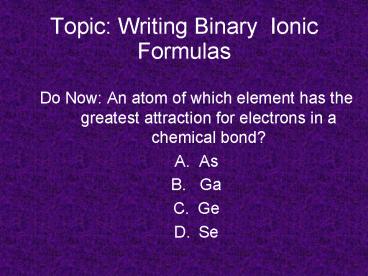Topic: Writing Binary Ionic Formulas - PowerPoint PPT Presentation
Title:
Topic: Writing Binary Ionic Formulas
Description:
Topic: Writing Binary Ionic Formulas Do Now: An atom of which element has the greatest attraction for electrons in a chemical bond? As Ga Ge Se Empirical Formulas ... – PowerPoint PPT presentation
Number of Views:119
Avg rating:3.0/5.0
Title: Topic: Writing Binary Ionic Formulas
1
Topic Writing Binary Ionic Formulas
- Do Now An atom of which element has the greatest
attraction for electrons in a chemical bond? - As
- Ga
- Ge
- Se
2
Empirical Formulas
- smallest whole-number ratio of elements in
compound - Ionic compounds have empirical formulas only
3
Identify the empirical formulas
- H2O
- H2O2
- CaF2
- NaCl
- CH4
- C2H6
- NiO
- FeCl3
Empirical NOT ionic
Molecular NOT ionic
Empirical, Ionic
Empirical, Ionic
Empirical NOT ionic
Molecular NOT ionic
Empirical, Ionic
Empirical, Ionic
4
Formula Unit
- simplest ratio of ions in ionic compound
- Examples
- KBr is formula unit
- potassium ions bromide ions are in a 1-to-1
ratio - Al(NO3)3 is formula unit
- Aluminum nitrate ions in 1-to-3 ration
5
Binary Ionic Compounds
- Composed of two different elements
- Positive monatomic metal ion
- Negative monatomic nonmetal ion
Note A binary compound may contain more than 2
ions but only 2 kinds of ions like Al2O3
6
Oxidation Number or State
- charge of monatomic ion
- has right superscript
- Some elements form only 1 ion
- Some elements can form more than 1 ion
7
Oxidation States
- Group 1 ions always 1
- Group 2 ions always 2
- MOST group 13 ions are 3
- Groups 14, 15, 16, and 17 have multiple oxidation
states - both () and (-)
- Transition metals (Group B) can have more than 1
oxidation state - but are always ()
8
Writing Formulas for Binary Ionic Compounds
- first rule in writing formulas for ionic
compounds is - POSITIVE ION FIRST
But how do you get the subscripts?
start by writing formulas from the ions
9
- Compounds are electrically neutral
- Sum of all charges in compound
- should be 0
- () and (-) charges must each other
10
Equal but Opposite Charges
- Na1 and Cl-1 NaCl 1 (-1) 0
- Mg2 and O-2 MgO 2 (-2) 0
- Al3 and P-3 AlP 3 (-3) 0
- Rule write symbols, () FIRST!
11
Try a few formulas
- Li1 and I-1
- Ca2 and O-2
- Al3 and N-3
- K1 and F-1
- Ba2 and S-2
LiI
CaO
AlN
KF
BaS
12
Criss-Cross Method
- When the charges dont cancel out immediately
- Mg2 and Cl-1, CROSS and DROP!
- ( only, forget
signs!)
- Mg1Cl2 but if subscript is 1, forget it!
- MgCl2 means 1 Mg2 and 2 Cl-1
13
Check the Math
- MgCl2 means 1 Mg2 and 2 Cl-1
- (1 x 2) (2 x -1) 2 -2 0
- charges MUST add up to zero!
14
Try a few formulas
CaCl2
- Ca2 Cl-1
- Na1 O-2
- Cs1 S-2
- Al3 Cl-1
- Al3 Se-2
- Mg2 F-1
- K1 N-3
Na2O
Cs2S
AlCl3
Al2Se3
MgF2
K3N
15
Of course, it gets more difficult
- Potassium (K) and Fluorine (F)
- Zinc (Zn) and Iodine (I)
- Sodium (Na) and Oxygen (O)
- Magnesium (Mg) and Oxygen (O)
- Aluminum (Al) and Oxygen (O)
- Calcium (Ca) and Bromine (Br)
- Cesium (Cs) and Iodine (I)
- Silver (Ag) and Sulfur (S)
KF
ZnI2
Na2O
MgO
Al2O3
CaBr2
CsI
Ag2S































